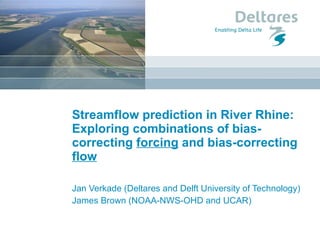"Streamflow prediction in River Rhine: Exploring combinations of bias-correcting forcing and bias-correcting flow
- 1. Streamflow prediction in River Rhine: Exploring combinations of bias-correcting forcing and bias-correcting flow Jan Verkade (Deltares and Delft University of Technology) James Brown (NOAA-NWS-OHD and UCAR)
- 2. Motivation and research questions Biases/uncertainty in predicted forcing used for streamflow prediction: NWP models are skillful, but biased (mean, spread,..) This bias/uncertainty propagates from forcing to flow Bias-correction of precipitation is complex Ultimately, flow bias-correction is always needed Key research questions: What is the signal from bias-correction of forcing in streamflow? Is this signal maintained after bias-correction of flow , i.e. is forcing correction needed?
- 3. Research design Raw forcing (T,P) Hydrologic model Raw flow Ensemble verification B-C forcing (T,P) Hydrologic model Raw forcing (T,P) Hydrologic model Scenario 1 Scenario 2 Baseline B-C streamflow B-C streamflow
- 4. Ã˝
- 5. Data kindly provided by Florian Pappenberger @ ECMWF
- 6. Observed forcing data: E-OBS dataset Downloadable from KNMI @ http://eca.knmi.nl/
- 7. Bias-correction of temperature, precipitation and flow The random variables (one time/location): Predictand Y = observed temp/precip/flow. Assumed unbiased! Potential predictors X = {X1,…,X5,…, Xm}; biased. The bias-corrected forecast: How to parameterize for T and P? Parsimonious model (subject to skill!) Model the statistical dependence (“traces”)
- 8. Bias-correction of temperature, precipitation and flow (2/2) Temperature normal regression: linear regression in normal space Precipitation logistic regression: linear regression in logistic space Streamflow: Krzysztofowicz approach: Hydrologic Uncertainty Processor Prior: unconditional climatology Posterior: distribution of flow conditional on ensemble mean
- 9. B-C: preservation of space-time dependencies How to parameterize dependence? Space-time patterns of T and P Cross-variable dependence in T and P Critical for streamflow prediction Empirical approach Based on “Schaake shuffle” (Clark et al.) Shuffle the bias-corrected ensemble members to preserve rank-ordering of the raw ensemble members
- 10. Skill of T correction CRPSS = “% gain” over raw forecast ~20-60% gain Gradual decline with lead time
- 11. Skill of P correction ~20-30% gain Faster drop after 24 hour lead time
- 12. Skill of P correction for > “1-in-10 day” observed P amount ~small gain or loss Failure of logistic regression to remove conditional bias (under-prediction of large P)
- 13. Skill of S for T and P correction. ~-10% to +10%
- 14. Skill of S for > “1-in-10” day observed S, with T and P correction. ~-40% to +20% Loss of skill at long lead times. Caution when “correcting” high P at long lead times!
- 15. Next steps Q1: “What is the signal from bias-correction of forcing in streamflow?”: Some way towards answering that question Need to establish why skilful forcing correction is not consistently translating into flow skill. Could it be due to the space-time and cross-variable dependence (“Schaake Shuffle”)? Try Brown and Seo (2011) approach to conditional bias (bias-penalized kriging) Next, we’ll focus on Q2: Is the signal from forcing bias-correction lost following flow bias-correction?
- 16. Questions? (slides available from slideshare.net/janverkade) Contact: jan.verkade@deltares.nl, twitter.com/janverkade [email_address]
Editor's Notes
- #5: Basin: Rhine basin (approx. 160e3 km2), focus on Moselle sub-basin Available modeling system: HBV rainfall runoff model at daily time step Within a Delft-FEWS forecast production system (CHPS)
- #6: 3164 “issued” reforecasts between 1991 and 2010 1/10th-by-1/10th degree 30 days leadtime  we use 10 days only
- #7: E-OBS is a daily gridded observational dataset for precipitation, temperature and sea level pressure in Europe. The full dataset covers the period 1950-01-01 until 2011-06-30. It has originally been developed as part of the ENSEMBLES project (EU-FP6) and is now maintained and elaborated as part of the EURO4M project (EU-FP7).
















![Questions? (slides available from slideshare.net/janverkade) Contact: jan.verkade@deltares.nl, twitter.com/janverkade [email_address]](https://image.slidesharecdn.com/2011-02-08verkadeandbrown-agu-111207190811-phpapp01/85/Streamflow-prediction-in-River-Rhine-Exploring-combinations-of-bias-correcting-forcing-and-bias-correcting-flow-16-320.jpg)